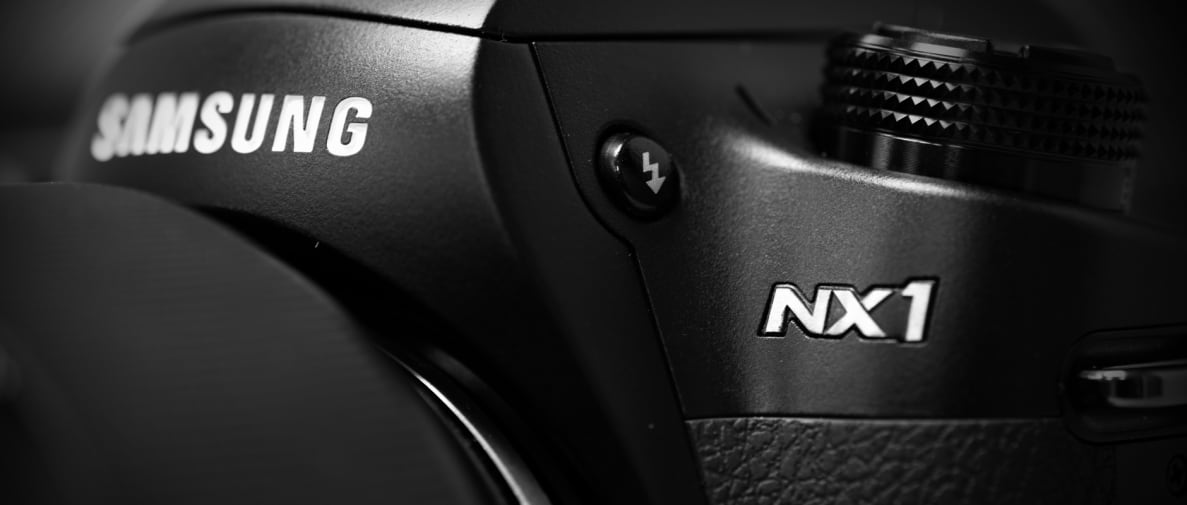Pros
Cons
Though Samsung Electronics is itself over 40 years old, its reputation in the camera industry doesn't compare to the likes of Canon, Fujifilm, Olympus, Sony/Minolta, and Nikon. Nikon's been using the same lens mount for over 50 years, after all. Since 2010, Samsung has put a lot of time, effort, and money into developing its NX family of interchangeable lens cameras. But while Samsung's cameras are respectable and often great values, relevancy in the camera market has remained elusive.
{{brightcove '3911506682001'}}
No longer. The Samsung NX1 is not just the best camera Samsung has ever produced, it's one of the best cameras you can buy in this price range. Though Samsung's ecosystem is not nearly as robust or as proven as its competitors, the NX1 can go toe-to-toe with any camera in this part of the market in terms of raw performance. With 4K video, 15fps burst shooting, and class-leading autofocus tracking and speed, the NX1 is not just a respectable entry into the high-end mirrorless camera segment—it may be the camera to beat.
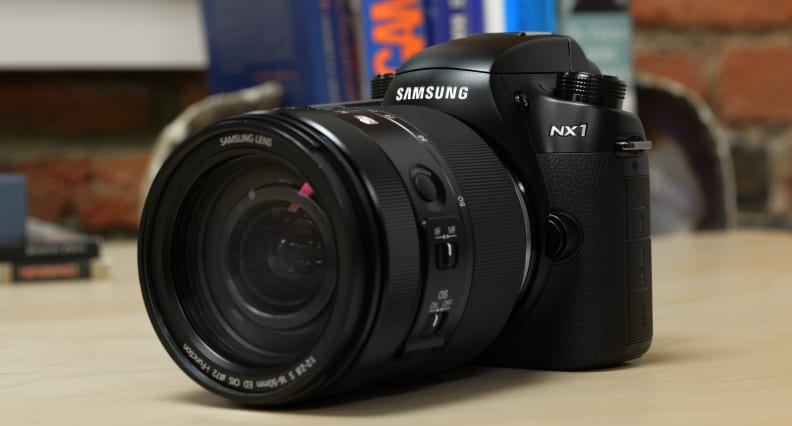
The NX1 is Samsung's flagship mirrorless camera, with a design that's like a beefed up NX30.
Design & Handling
It won't appeal to pros or retro-loving enthusiasts, but the NX1 is both powerful and approachable.
The last few Samsung cameras have followed a very similar design aesthetic, with friendly curves, an emphasis on "Smart" wireless features, and clearly labeled controls backed up by a straightforward menu system. They were cameras for novice users who were either familiar with or coming directly from using a smartphone camera as their daily driver. The NX1 stays the course here, feeling like an expanded version of Samsung's lower-end NX30 rather than some new, top-tier machine. But compared to the NX30 there's simply more going on, including three control dials, an articulating 3-inch LCD, and a secondary monochrome LCD on the top plate—a first for Samsung cameras.
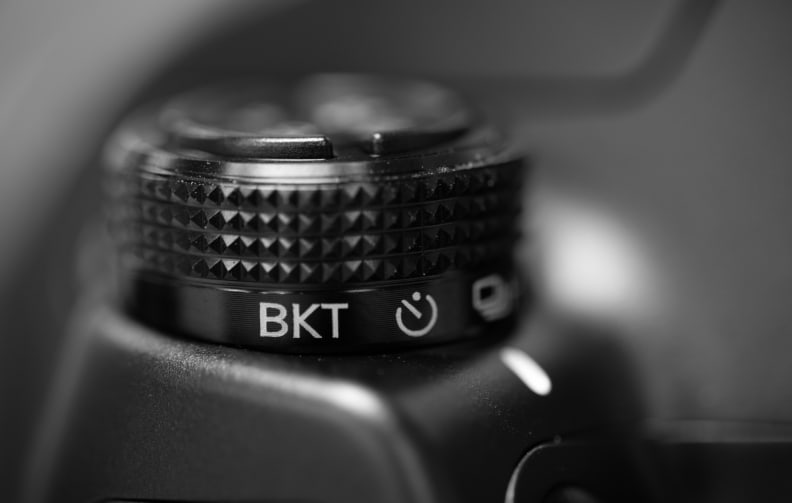
Like high-end Nikon DSLRs, the NX1 has a cluster of controls on the top plate of the camera, to the left of the EVF.
When you pick up the NX1 it's clear that, even if Samsung is borrowing some ideas from its competitors, it's at least picked the right inspirations to draw from. The grip is large and curvy, with a deep recess, large thumbrest, and a rubberized coating that provides plenty of purchase. The camera slots easily into your hand, with just the right amount of heft to balance against heavier high-end lenses. The three control dials are well-placed, with a top dial located just behind the shutter button/power switch and two control dials around back easily accessed by the thumb.
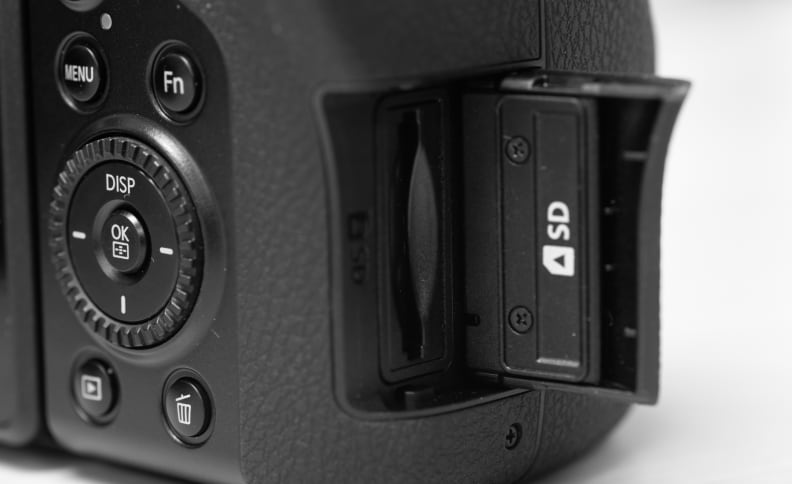
The NX1's compact size is a big benefit, but the lack of dual card slots is a downer for pros who need the space.
One area that's not easily accessed, however, is the top-plate control cluster. It's found on the left side of the EVF mound. That'll feel just fine for Nikon shooters used to their high-end DSLRs, but it does mean some important controls—ISO, white balance, drive, metering, and focus—require a second hand to operate. To assuage this Samsung has included a simple function menu, brought up by pressing the Fn button just above the rear control dial.
Pressing this button lets you access nearly every major setting on the camera, including exposure, metering, focus, and color settings. Once you've got things set up the way that you like, you can also save all these settings as a custom profile—including which shooting mode you were in. You can store a number of these profiles in the camera, giving them their own names and binding them to either of the two custom settings on the mode dial itself.
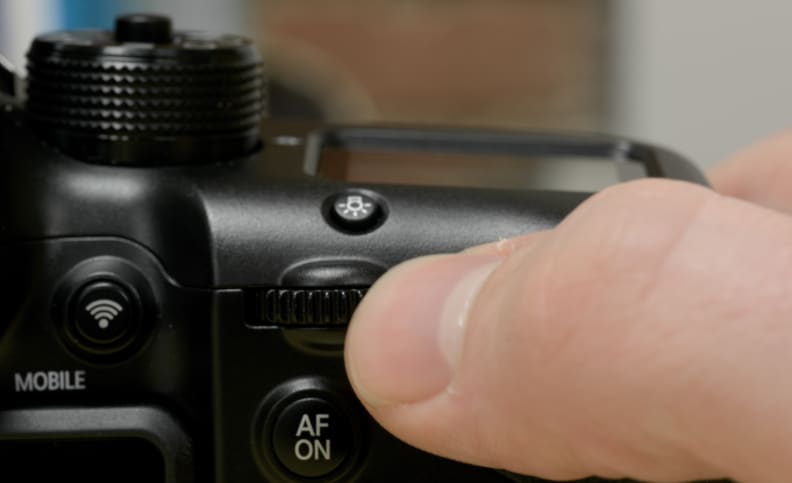
One of the main additions to the NX1 over the NX30 is a second control dial just above the thumbrest.
That customization is essential to getting the most out of the NX1. The body is barely bigger than the NX30, and to make room for a secondary LCD and a third control dial Samsung had to move the drive switch and a number of controls out of the way. As a result the only controls you can easily access with your right hand by default are the shutter button, control dials, exposure compensation, focus, and auto exposure lock. It's a worthy trade-off, and at least you can map three of the directional buttons to be whatever else you need.
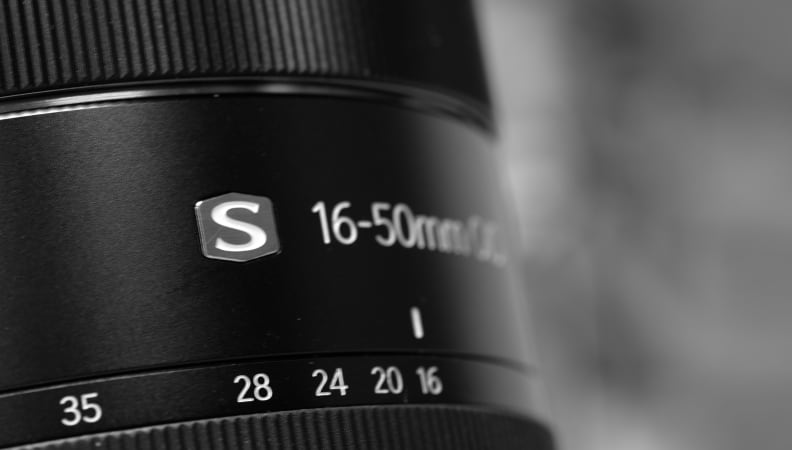
Samsung's new "S" series lenses have proven to be excellent so far, but there are precious few options available.
If there's one thing that's sorely lacking here it's the premium feel that we've enjoyed on some other high-end mirrorless cameras like the Olympus OM-D E-M1, Sony A7, and the Fujifilm X-T1. The NX1 actually feels quite similar to the Panasonic GH4 in that way, and it's likely because its essentially a chunkier NX30. This feels like a $1,000 camera pumped up with more features rather than an expensive, pro-grade camera trimmed down to cut costs. It's perfectly functional, but it doesn't immediately lend a sense of quality like those other cameras do.
Of course, that doesn't mean the NX1 isn't just as durable. It's sealed against moisture and dust that, when combined with any of the weather-sealed S-series lenses, should provide plenty of protection against the elements. We took the NX1 out with its S-series kit lens and had no troubles at all, with the NX1 performing just as well in inclement weather as on any other day.
{{ photo_gallery name="tour" }}
Features
The NX1 has a beefy resume, but the h.265 video is clearly ahead of its time.
There's a reason why the Samsung NX1 has been one of the most anticipated cameras to be announced this year. On paper, this is one of the most complete cameras on the market. For starters it has a 28.3-megapixel APS-C image sensor—a size on par with most high-end DSLRs, Fuji's X-T1, and much bigger than the Four Thirds sensors in the Panasonic GH4 and Olympus E-M1. The sensor is the first backside-illuminated APS-C sensor and is capable of recording 14-bit RAW files.
The sensor also has a whopping 205 phase-detection autofocus points built right in, which are functional even when shooting video. It can sample the autofocus points up to 120 times per second, giving it excellent AF tracking abilities and some unique sports shooting tricks. It can also capture bursts of up to 15 frames per second (in RAW, JPEG, or RAW+JPEG) while continuously focusing.
On the video side of things this is the second system camera (after the Panasonic GH4) that can record UHD/30p (henceforth "4K") video to SD memory cards—no external recorder required. Unlike the GH4, you don't even need to invest in newer high-speed UHS-3 SDHC cards—the h.265 recording means simple class 10 SDHC cards generally work just fine. On the connectivity side you've also got USB 3.0, NFC, and speedy built-in 802.11ac WiFi.
Of course, Samsung also brings its display manufacturing abilities to bear, providing both a 2,360k-dot XGA OLED EVF and a 3-inch 1,036k-dot articulating Super AMOLED touchscreen. The screen doesn't swivel out and forward like the GH4's, but it's serviceable enough for use on a tripod or for framing at odd angles.

The Samsung NX1 is tack sharp with the kit lens, while its large APS-C sensor and f/2 maximum aperture provide a shallow depth of field.
The panels themselves are very sharp, bright enough to be visible during the day, and the rear touchscreen is responsive and accurate. The OLED EVF also has very little lag, though there's a subtle color temperature shift between it and the rear monitor. There's a menu option that should correct this, but we found it didn't quite close the gap. The eyepoint on EVF also feels just a little too far away, so the eyecup introduces some vignetting unless you press your eye right up against it—a real problem if you shoot with glasses on.
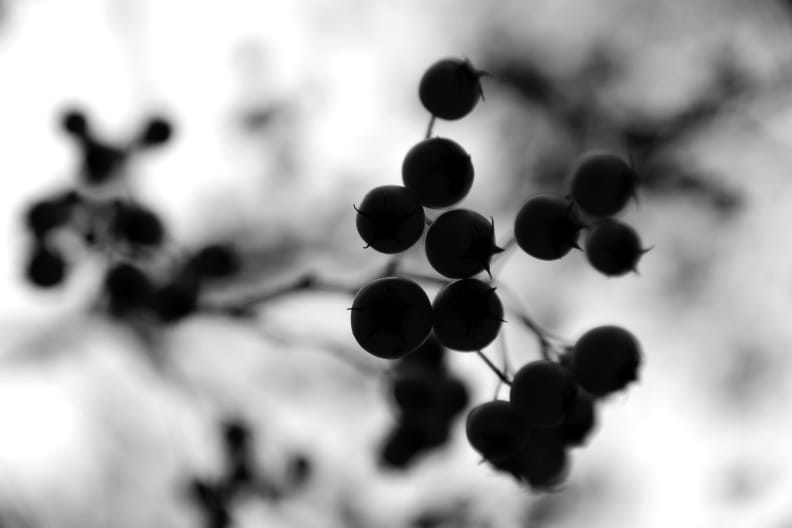
The 16-50mm lens has decent bokeh when up close, though it can be a little busy at times unless you stop down.
From a photographer's perspective, the NX1 is powerful without being that intimidating; novices will still struggle, but the learning curve isn't as steep as you might think. Helping this is the presence of several scene modes, color profiles, and helpful extras like timelapse/interval shooting. This should help the NX1 to feel a little friendlier, with customization options allowing you to tailor the experience to your needs once you learn your way around.

This shot came out very flat from the camera, but in Photoshop it proved to have plenty of life.
All in all the NX1 matches up well with competing cameras in this part of the market. It doesn't feel quite as no-nonsense as the Canon 7D Mark II, but it's not as free-wheeling as the Olympus OM-D E-M1. It lacks for the Fujifilm X-T1's soul and the GH4's glut of video features. What it does do is strike an excellent balance, including all the manual control an advanced shooter would want while not leaving novice shooters out in the cold.
Video Features
HEVC is the future, but you'll need a rig from the future to edit it.
For video shooters, the NX1 is an even mix of tantalizing promise and incredible frustration. For starters, the good: the NX1 provides you with full manual control over exposure, full phase-detect autofocus while recording video, and both headphone and mic jacks. It also allows you to make use of focus peaking, focus assist zoom, and highlight/zebra warnings while recording. The bones are here for a superb 4K/UHD-shooting interchangeable lens camera, even if there isn't quite the granular level of control provided by the Panasonic GH4.
Unfortunately, actually working with the UHD footage is where things become very messy. The Samsung NX1, like the Panasonic GH4 and Sony AX100 camcorder, can record UHD/4K footage internally to SD cards. The GH4 and Sony AX100 both use versions of the H.264 codec (in the form of AVC and XAVC S), which supports 4K footage but requires UHS-1 and faster SD cards because of the sheer amount of data. The NX1 can record 4K to regular Class 10 SDHC cards because it uses newer HEVC (H.265) compression. HEVC compression is around 50% more efficient than H.264, but it reportedly requires 3-10x as much computing power to encode/decode.

The 85mm f/1.4 lens is perfect for situations like this, but chromatic aberration and focus consistency issues dogged this shot.
The extra required horsepower is a big issue because while every modern graphics card supports H.264 natively, hardware HEVC support isn't widespread. This requires software-based encoding and decoding, which is far slower. For example, even brand-new Maxwell 2 GeForce 900-series cards from Nvidia will only offer a mix of hardware and software support for HEVC. Worse still, in practice we couldn't edit the footage in either Final Cut Pro or Adobe Premier Pro. Forget editing—even playing back the footage on a PC was a pain in the neck.
The only ways we could view what we shot were directly from the camera (which was plagued by artifacting and choppiness) or using Divx 10—VLC, Quicktime, and other common players couldn't play the footage smoothly at all. And even with Divx the only computer we found that could run it was the Razer Blade Pro, a $2,500 high-end gaming laptop. Even our i7-based Macbook Pros struggled. HEVC footage is the future of 4K streaming, but with hardware support at least 18 months away we recommend using a 4K-ready external recorder or converting the footage to H.264 before trying to work with it.
Performance
The NX1 isn't perfect, but it's extraordinarily powerful for the price.
As feature-rich as the NX1 is, nothing matters if the images don't look good. As with video, things are mostly promising, with a few major caveats. The NX1 is just as fast as advertised, offers dynamic range on par with its closest competition, and records excellent video in both 4K and HD.
The first test we run with every camera is color accuracy, and this was the main area where the NX1 ran into trouble. The NX1's JPEG output looks good with certain scenes, but it struggles to reproduce accurate colors. Blues, in particular, seem overemphasized at the expense of green channel saturation. This appears to be intentional on Samsung's part, as the camera's white balance system is incredibly accurate. With both auto and custom white balance you can expect accurate neutral shades regardless of lighting condition.

At ISO 800 the NX1's shot is still noise free, though there's a little less range in the SOOC JPEG shots.
In low light, the NX1 can shoot at ISO speeds ranging from 100-51,200 (expanded). We found that noise was generally very well controlled through ISO 6400. With noise reduction turned off the out of camera JPEGs captured very fine detail, preserving it while keeping noise under 1% through ISO 800 and under 2% until ISO 12,800. The backside-illuminated sensor absolutely pays dividends here, with usable shots up through ISO 6400. It doesn't blow by the competition, but it's on par with the best APS-C sensors we've seen this year.
In our dynamic range test the NX1 also did very well, with at least 12.5 stops of dynamic range based on our initial analysis. For this test we shoot at every ISO in RAW, converting shots with Adobe Camera RAW with zero noise reduction. Because ACR has yet to be updated with NX1 support, we're currently relying on a Samsung-provided RAW-to-DNG converter, then putting that through our usual workflow. Though our lab tests show minimal (if any) noise reduction, we feel confident in the results but will revisit them once ACR is updated.

The Samsung NX1's 16-50mm kit lens and 28MP sensor give you the ability to get sharp photos and crop in on your subject.
With that setup we're seeing 13.3 stops of dynamic range going by the ISO standard, which counts range until the signal-to-noise ratio (SNR) drops below 1. We score using a higher standard (SNR=10), and there we're seeing around 7.8 stops of range at base ISO. Though 13.3 stops would make the NX1 one of the better APS-C cameras on the market, the lower 7.8 result puts it merely among the better ones available. Either way, it's very good.
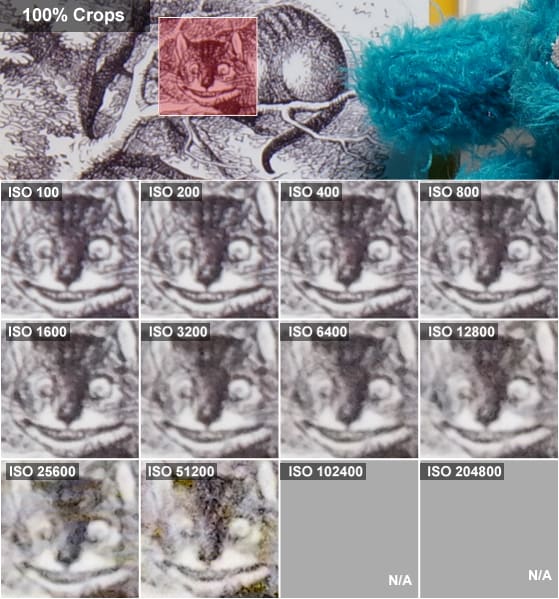
Noise reduction is gentle and effective.
But where the NX1 truly shines is in continuous shooting. The camera can fire bursts at a whopping 15 frames per second at full resolution. Given that pro cameras like the Nikon D4S and Canon EOS-1D X can manage just 12fps, it's clear how neck-snappingly swift this camera truly is. The NX1 also has the benefit of one of the faster, most accurate autofocus systems we've used on a mirrorless camera. The full 205-point PDAF system baked into the sensor isn't quite as good in low light as the best Canon and Nikon have to offer, but otherwise it's good enough for most kinds of photography—with the right lens.
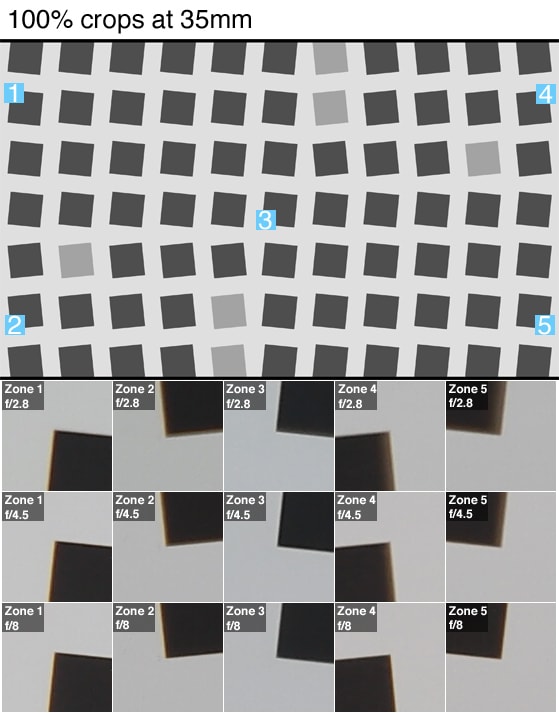
Chromatic aberration rears its ugly head on sharp edges.
With the 16-50mm S-series lens, the NX1 completely lived up to its billing. It was fast, accurate, and tracked motion very well. Though it wasn't quite as fast with the 85mm f/1.4 portrait lens, we were still generally impressed with the NX1's abilities. It doesn't match up to the Canon 7D Mark II, and there are situations where the Olympus E-M1, Fuji X-T1, and the Sony A6000 are slightly faster, but with moving subjects and in limited light the NX1 is the best all-around focus system we've used in a mirrorless camera.
In video, the NX1 separates itself from everybody except the Panasonic GH4 when it's at its best. The 4K video resolved more fine detail than even the GH4. In low light the NX1 can record usably bright video with just two lux of light, as well, with very little visible noise through ISO 3200.
The main issue here is Samsung's use of H.265/HEVC compression. Nothing we tried could smoothly play back the footage, even when using a top-of-the-line Macbook Pro. Even when playing back directly from the camera there were loads of visible artifacts and choppiness. Your mileage may vary depending on your setup, but there's no simple way to work with this footage, eliminating most of the benefit of the HEVC compression in the first place.
{{ photo_gallery name="Samples" }}
Lens Ecosystem
Samsung is on its way, but it isn't there yet.
One of the areas where the Samsung NX1 is sorely lacking compared to its competitor is in the supporting ecosystem. Samsung has been making cameras for some time, but the NX mount cameras have only been out since early 2010. Though the NX cameras actually precede Sony's own E-mount cameras, Samsung has struggled to find a foothold in the camera market—at least, enough of a foothold to justify the kind of R&D expense that comes with developing a complete high-end lens lineup.
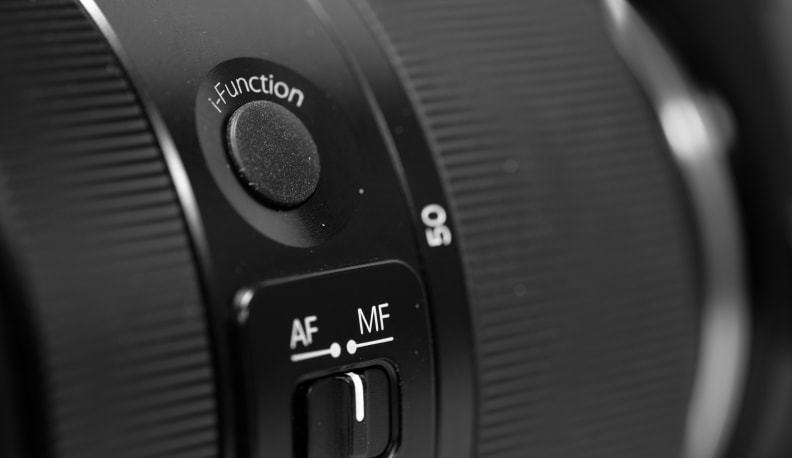
We respect Samsung's commitment to the i-Function feature, but it doesn't have that much utility here.
Instead, Samsung has been slowly chipping away at the problem. The result is a lens family that has more options than you might expect, but lacks the litany of high-quality options that you can already find with Olympus, Fujifilm, Sony, and Panasonic mirrorless cameras, let alone Canon and Nikon DSLRs. This isn't to say all of Samsung's lenses are bad—quite the contrary—but the great ones are few and far between.
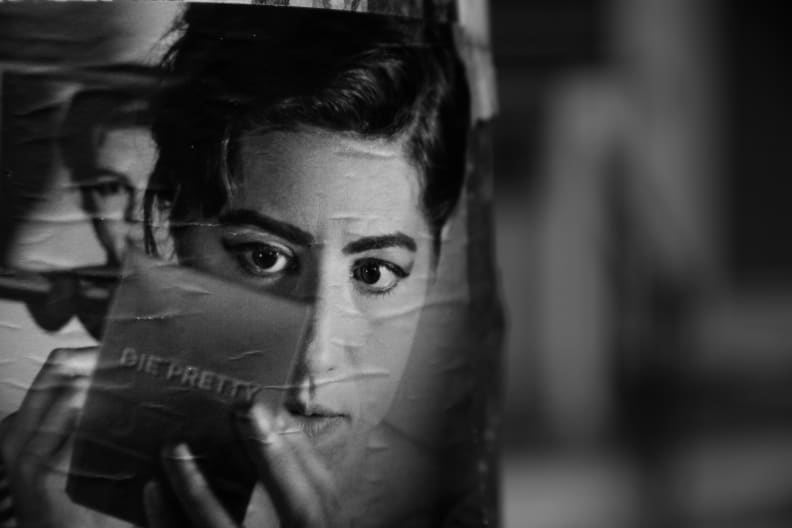
Even with just the SOOC JPEG shots, there's enough dynamic range to give you plenty of editing latitude.
Luckily, the 16-50mm f/2-2.8 S lens that ships alongside the NX1 is one of the best fast zoom lenses we've seen for a mirrorless system. It nicely approximates the field of view of a 24-70mm f/2.8 lens on a full-frame camera, with the added benefit of opening up a little more on the wide end. It's tack sharp and fully weather-sealed, complementing the NX1's own weather sealing quite nicely. A 50-150mm f/2.8 S lens and a 300mm f/2.8 S lens are also on the way, but we'll reserve judgement until we get our hands on them.

The Samsung 85mm f/1.4 lens isn't as fast as the kit lens, but it can still be a useful street shooting lens.
For non-sealed lenses we're big fans of the 60mm f/2.8 macro, the 45mm f/1.8, and the 85mm f/1.4 portrait lens. The 60mm and 85mm are larger than similar lenses for other mirrorless systems, but they're both very sharp, produce excellent, and fill useful holes in the lineup. Their larger size is burdensome on smaller NX cameras like the NX30, but with the NX1's large grip even the hefty 85mm feels just fine—though the autofocus was a little slow.
Beyond that, it's slim pickings for the time being. There are plenty of useful, affordable lenses in the lineup, but few that will push the NX1 to its limit. The major focal lengths are covered, but without widespread third party support it'll be some time before Samsung catches up to the sheer volume of low-cost, high-quality options you can get with competing systems.
Conclusion
Samsung has a winner on its hands, but can it replicate its success from other markets?
Samsung has been on a meteoric rise in the consumer tech space in the last decade. The South Korean company has invested billions into developing some of the most advanced technology available today, bullying its way to market dominance in categories like televisions, displays, home appliances, smartphones, and tablets. The photography market has escaped Samsung's grasp, however, as buyers have generally stuck with companies that can call on longer-lasting photographic legacies.
The NX1 makes a strong case that Samsung deserves recognition for the high-quality cameras it's capable of producing. From a raw performance perspective, the NX1 can easily match—and often exceeds—the capabilities of the Olympus OM-D E-M1, the Panasonic GH4, the Fujifilm X-T1, and the Sony A7 cameras. It also soundly outpoints the Nikon D7100 and Canon 70D in many key ways, especially capture speed. Though you could very easily make a compelling case for any of those cameras as being the best choice depending on your needs, the NX1 has perhaps the best all-around resume of the lot.
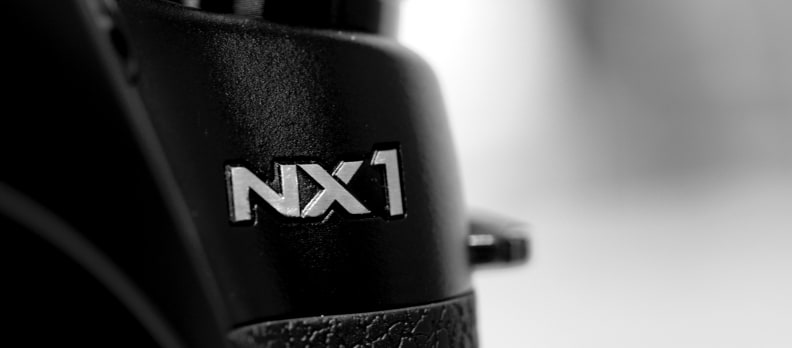
The NX1 is Samsung's best camera by far—now it just needs the ecosystem to go with it.
That's no small feat, but this is a camera with a very good APS-C sensor that is capable of firing bursts of up to 15 frames per second. It has 205 phase-detect AF points built right into the sensor, easily tracking action even in moderately dim settings. It offers dynamic range on par with all of its competitors (non-full frame division), shoots at up to ISO 51,200, and has one of the most accurate white balance systems we've ever tested. For video shooters you get full manual control, razor-sharp (albeit frustrating) 4K/30p video straight to Class 10 SDHC cards, built-in mic/headphone jacks, USB 3.0 output, and clean 8-bit 4K video out to an external recorder.
It's a dynamic, powerful camera that promises better video quality than every mirrorless camera except the GH4, while narrowly besting Panasonic's baby with faster still shooting and superior autofocus performance. Looking at the NX1's performance purely in a vacuum, it's the best high-end mirrorless camera we've seen yet.
Of course, picking a camera isn't about just choosing the camera with the most horsepower. There are lots of credible reasons for skipping the NX1: it lacks dual card slots, H.265 video is currently a nightmare to work with natively, and the NX1's color rendition leaves a lot to be desired. Crucially, Samsung has a long, long way to go to match its competition in terms of lens availability, accessory ecosystem, third party lens support, customer service reputation, and durability.
But Samsung seems up for the challenge. Samsung proved with the NX300, NX3000, and NX30 that it can make good cameras. The NX1 is its first great one. The S-series lenses we've shot with so far are also all excellent, and were a company like Sigma or Zeiss to begin supporting the NX mount the lens situation could change quickly. It's early days for Samsung's NX mount, but this is a camera the company should hang its hat on.
Building a legacy takes time. The NX1 is just the first step.
By the Numbers
It's safe to say that the Samsung NX1 is the surprise camera of 2014. It seems Samsung is finally getting serious about its mirrorless camera lineup, loading the NX1 for bear and setting it up to compete with some of our favorite cameras of the past 18 months. Though Samsung has a long way to go to win the hearts and minds—not to mention wallets—of advanced photographers, the NX1 is an incredibly potent device built to stand toe-to-toe with any high-end mirrorless camera on the market.
Editor's Note: Though several of our tests are run using straight out of camera JPEGs, several of our tests require RAW support for analysis. Our usual workflow involves putting the RAW files straight into Adobe Camera Raw and developing them in Lightroom. For the time being we are using a Samsung-provided RAW-to-DNG converter and then putting the DNGs into Lightroom. We're confident in our results, but to ensure accuracy we will update the review once Adobe Camera Raw is updated to support the NX1's files.
Color Accuracy & White Balance
We were incredibly excited to get the NX1 with its final retail-ready firmware into our labs, but the NX1's initial results failed to impress. The first test we run with every camera is one that looks at the camera's color accuracy when shooting in JPEG modes. This gives us a good baseline for how the camera will expose scenes and what the image processing engine is trying to accomplish.
With the NX1, we're not entirely sure what Samsung is going after. The camera comes with a number of customizable color settings called "Picture Controls" that let you adjust how the camera processes color when recording JPEGs. None of them were particularly accurate, however, including just shooting with the feature off entirely. Though the NX30 gave us no problems in this area, the NX1 seemed unable to produce a color error (∆C00 saturation-corrected) of less than 2.5. Anything less than 3 is acceptable, but we typically see average errors under 2.2.

With a little work, we're actually quite happy with the colors you can achieve using just SOOC JPEG images.
The most accurate profile in this case was "Standard," but that came with blues, greens, and magentas that were too heavily saturated. Even tweaking the color profiles to lower saturation didn't seem to help, as that just threw other colors out of whack.
One thing that the NX1 did get right, however, was white balance. The NX1 features some of the best automatic white balance we've seen in any camera, regardless of lighting conditions. We test in three lighting conditions—fluorescent, daylight, and incandescent—to see how cameras handle them. The NX1 had color temperature errors of less than 450 kelvins in tungsten, 150 kelvins in fluorescent, and 60 kelvins in daylight. We typically see errors at least double that, putting the NX1 among the best we've seen in this test.
If you absolutely need pitch-perfect white balance then you can easily set a custom white balance with a neutral gray card. When we went that route the NX1's performance got even better, with errors of 60 kelvins or less in all three lighting setups.
Noise Reduction and High ISO Shooting
The NX1 has an ISO range, when extended, of 100-51,200. It can shoot in JPEG, RAW, or RAW+JPEG with four noise reduction settings: off, low, normal, and high. We put them all to the test and, while the NX1 doesn't quite stand up to the latest full-frame sensors on the market, it's certainly in line with other high-end APS-C DSLRs.
With noise reduction set to "off" you can expect noise to hover around 0.6% at ISO 100, rising steadily but staying under 1% through ISO 800. From there noise climbs from 1.19% at ISO 1600 to just over 2% by ISO 12,800. It stays under 3% at ISO 25,600, but jumps all the way to 6.08% at max ISO. Even in this "off" setting, however, it's clear there's some noise reduction going on.

Noise reduction is gentle and effective.
Actually activating the noise reduction doesn't change much, and even between the three levels—low, normal, and high—there's not much practical difference. The noise profile is almost identical to the "off" setting through ISO 3200. At ISO 6400 any level of noise reduction will keep noise to 1.3% instead of 1.9%. At ISO 12,800 and 25,600 noise will stay below 2% at all noise reduction levels, hitting 4.8% noise at max ISO.
In general, the noise reduction system does an acceptable job or retaining fine detail through ISO 6400, producing usable images that should be printable. With noise reduction set to high you can even get usable images at ISO 12,800. Anything beyond that will either require a very careful hand editing or will only be acceptable for very small prints and web resolution.
Dynamic Range
The Samsung NX1 features the first backside-illuminated APS-C sensor on the market. Backside-illuminated sensors theoretically allow for greater dynamic range than frontside-illuminated sensors because they relocate much of the circuitry behind the active pixels on the sensor, which should increase signal to noise ratio in certain scenes. That extra SNR pays dividends chiefly when it comes to increasing dynamic range.
Dynamic range is just the range of light levels that the sensor can record, counting from completely saturated (white) to the point where you can no longer reliably tell the difference between luminance caused by incoming light and luminance caused by noise. The engineering definition (and the one most commonly used by camera manufacturers) sets this bottom level at the point where signal and noise are equal (SNR=1).

The Samsung NX1 is tack sharp with the kit lens, while its large APS-C sensor and f/2 maximum aperture provide a shallow depth of field.
At this level—which Imatest calls "Low"—the NX1 managed a fantastic score of 13.3 stops at ISO 100. If you raise the threshold from an SNR of 1 to an SNR of 10, the NX1's dynamic range drops to a still-healthy 7.81 stops at ISO 100, dropping over time to around 4.6 stops at ISO 800 and holding on to 1.46 stops at ISO 6400. This is about on par with other APS-C cameras on the market from Canon, Nikon, Pentax, and even newer Micro Four Thirds cameras like the Olympus E-M1 and Panasonic GH4.
In practice, we found the NX1's files came in closer to the pack than the 13.3 stops figure would suggest. The RAW workflow we have currently does show that these shots hold onto highlight detail very well, but there is quite a bit of noise in the shadows. Until Adobe supports the NX1 and we can put RAW sample shots through our usual editing workflow consider this point up for debate.
Editor's Note: Because dynamic range is limited by noise present in the final image, these results are very sensitive to noise reduction—hence why we shoot in RAW. Our analysis of the Imatest results indicated that there's very little—if any—noise reduction being applied, but it's possible that the "low" result of 13.3 stops is off slightly due to how the RAW-to-DNG conversion is done with Samsung's software. The "high" threshold is far less sensitive, so we're confident those results are comparable. We'll update these results and the review as soon as Adobe updates Camera Raw with NX1 support.
Continuous Shooting & Autofocus
One area where the NX1 is unquestionably the best in class is in continuous shooting and autofocus speed. Samsung's flagship can record full 28-megapixel resolution photos at up to 15 frames per second—much faster than competition and faster even than Canon and Nikon's top-end professional DSLRs. The NX1 has a whopping 205 phase-detect autofocus points, backed up further by 209 contrast-detect autofocus zones. That's all built right into the sensor, meaning its working in all shooting modes—including while recording video.
In our test the NX1 did indeed manage to rattle off 15 frames per second without breaking a sweat. Capacity was also impressive, with the ability to capture over 10 RAW+JPEG frames and over 30 JPEG frames alone before slowing down. Speaking of RAW+JPEG, the NX1 easily maintains its top speed even while recording both file types to the card. We'd still prefer if the NX1 had dual card slots for simpler archiving, but it's an impressive result nonetheless.
Video Performance
The NX1 is only the second consumer-grade interchangeable lens camera to record 4K/UHD video internally to SD cards. Unlike the GH4—the other camera with that capability—the NX1 can do it to bog standard Class 10 SDHC cards. That's potentially a huge advantage, as 4K video takes up a considerable amount of space, so cheaper storage solutions will save you lots of money.
Samsung manages this feat by using HEVC/H.265 compression, which is designed to replace the AVC/H.264 compression that most other cameras on the market use today. Though AVC has been extended to provide support for recording videos at UHD resolutions, it is not very efficient with those files. HEVC is designed specifically with 4K/UHD video in mind, promising space savings of 50% or more without quality loss.
HEVC video is certainly the future, allowing for incredible things like streaming 4K video over weak broadband internet connections without buffering. Unfortunately, support for HEVC codecs is still very limited. It is more efficient in terms of space versus quality, but it requires anywhere from 3-10x the computing power to encode and decode. You can speed that up with hardware-supported decoding, but there aren't any graphics cards on the market (that we know of) that feature true H.265 hardware support.
This means that though the NX1 will save you some money upfront by letting you use Class 10 cards you probably already own, you will find playing back the videos—let alone editing them—to be a true pain in the neck. You can play videos off the NX1 directly or put them on a flash drive and view them with many newer UHD televisions, but if you're planning a production workflow around the NX1 you'll have to spend a considerable amount of time converting the HEVC footage to H.264 before you can work with it.
If you do go through with that then you'll be rewarded with ultra-sharp footage. The NX1 resolved over 1100 line pairs per picture height vertically and horizontally on our resolution chart, with only minor moire issues when viewed at full resolution. The video suffered from a rather horrendous rolling shutter problem, however, so quick pans are generally out of the question. The NX1 was also very sensitive in low light, with those sharpness numbers barely taking a hit at 60 lux and the camera outputting 50 IRE video with just 2 lux of available light with the kit lens.
Meet the tester
TJ is the former Director of Content Development at Reviewed. He is a Massachusetts native and has covered electronics, cameras, TVs, smartphones, parenting, and more for Reviewed. He is from the self-styled "Cranberry Capitol of the World," which is, in fact, a real thing.
Checking our work.
Our team is here to help you buy the best stuff and love what you own. Our writers, editors, and experts obsess over the products we cover to make sure you're confident and satisfied. Have a different opinion about something we recommend? Email us and we'll compare notes.
Shoot us an email

